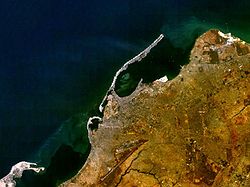History
When Paulo Dias de Novais, a Portuguese navigator, arrived here in 1575 with several hundred soldiers and settlers, the island was inhabited by the Axi-lwanda, a subgroup of the Ambundu people which was tributary to the Kongo Empire. The island was an important location to collect zimbo, the shells that constituted the currency of the Kongo king before the arrival of the Portuguese. [2] The Portuguese settled here for a while, gaining control of the currency, before they decided to establish themselves on the mainland, opposite the island. They started to use the name of the African inhabitants as a name for the island and the town, spelling it first "Loanda" and then "Luanda".
The Ilha, as it is called colloquially by the population, is connected with the city through a narrow passage [3] and is located at the foot of the Fortress of São Miguel. This is an area where residents can get away from the stresses of the capital, especially on weekends. A wide variety of hotels and clubs with bars and restaurants, as well as flea markets and marinas attract visitors.
The first church built by the Portuguese in Angola, the church of Nossa Senhora do Cabo is located here. [4] It was erected by some 40 settlers in 1575, before they moved to the mainland in 1576, founding the present capital of Luanda.
This page is based on this
Wikipedia article Text is available under the
CC BY-SA 4.0 license; additional terms may apply.
Images, videos and audio are available under their respective licenses.


